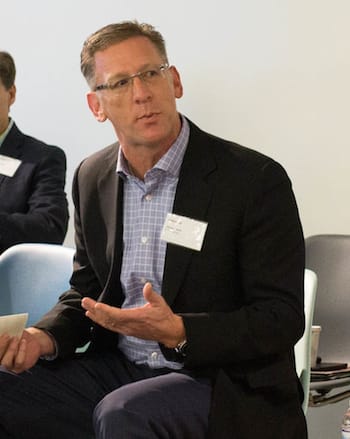The digital data universe is growing dramatically — doubling every two years by some estimates. But when it comes to the implications for health care, pragmatic questions remain: What are the possibilities of new applications that capitalize on digitized data? Why isn’t change happening faster? And what barriers are preventing adoption?

Jeff Hewitt, A.T. Kearney
I recently had the opportunity to facilitate a roundtable discussion on these topics during the “Digital Disruption: Value Shifts in Healthcare” summit co-hosted by A.T. Kearney and Chain Drug Review.
The assembled group included leaders across all segments of the health care sector for an open discussion about the implications of the data revolution. The discussion was led by panelists Jeff Bennett, chief executive officer of Higi; Kara Clark, vice president of health analytics, research and reporting at Walgreens; Richard Noffsinger, former CEO and president of Active Health Management; and Divya Errabelli, vice president of analytics at Health Dialog.
Proliferation of digitized data
The discussion began with an acknowledgement of the digital data and analytic platforms we have today that we didn’t have five to 10 years ago. Although the richness of claims data allows us to understand the total cost of care, there is an information lag that can delay data by three months or more. Electronic health records and digital pharmacies offer complementary information that is moving the industry toward a more all-encompassing view of the patient.
Beyond the traditional health information sources, the industry is making use of more diverse data sets such as ZIP code, shopping information, social media use, app-captured data and wearable tracker information. One summit participant said that a ZIP code has more to say about a person than we realize, as it is often a proxy for a patient’s income status, access to medicine and education. Combined with information from other data sources available at the individual patient level, ZIP codes make it easier to tailor engagement programs.
While there is broad acknowledgement of the potential to capitalize on wearable trackers in health care, not all consumers are engaged enough to use them. So how do you reach the roughly 70% of people who are hard to reach?

Cloud-based consumer engagement platform Higi has stepped into this space by providing self-service kiosks at Rite Aid Corp., Shopko Stores Operating Co. and other retail locations to collect data on blood pressure, pulse, weight, body mass index, hydration, and body fat. Future innovations will add more data. As patients become accustomed to taking these measurements at the kiosks or using home-based devices, the system acquires more traditionally valuable data from harder-to-reach individuals.
Range of possibilities
Summit participants were optimistic about the ability of data-enabled insights to improve health care. Possibilities range from applications to better understanding the most effective treatment protocols to identifying interventions that increase both the quality and the cost of care — and perhaps most optimistically, the opportunities to prevent diseases.
Static data sets are being mined to better understand which treatment algorithms work best for various patient cohorts. The pressure of a more competitive health insurance marketplace is placing emphasis on improving the health care value received for dollars spent. This marketplace dynamic has created more incentives to understand the treatment protocol that works best.
The availability of self-reported information, trackers and biometric data enables a better understanding of which patients are at risk. For example, wearable trackers that measure steps can alert a health coach if a patient’s activity decreases. More significant monitoring could include wireless scales to alert health professionals about fluid retention, signaling an impending congestive heart failure event. Having the visibility and the opportunity to engage with patients at the right time will prevent more serious and expensive events.
While the potential benefits of health trackers that measure activity, sleep and medication compliance are numerous, the group posed an important question: What will prevent insurance companies from giving incentives to people who use them? One view was that consumers will want to know if the data is being collected for their benefit or for their employers’ benefit. Another view focused on gaining a deeper understanding of the implementation challenges.
The discussion also covered the ways in which data that a patient sees as trivial might actually generate profoundly useful insights. For example, a smartphone can track consumers’ typing, and a decline in speed, accuracy or vocabulary might signal a cognitive impairment. Likewise, analyzing social media can translate a collection of “likes” or “retweets” into signs of potential suicide or misuse of drugs.
In isolation, individual data sets might have limited value, but in the right context, data can reveal helpful insights. One panelist argued that as the cost of data falls and the analytic capabilities improve, clinicians will have access to data-driven insights to target the right intervention for the right patient at the right time.
Slow to change
Past efforts to exploit data have been hampered by the significant time needed to collect and clean data, a lack of effective interpretive tools, and communication difficulties in disseminating those insights. What makes the situation different today is that we can benefit from automated sensors for data collection, powerful analytic engines, and cloud-based technologies to aid in sharing insights.
Data’s importance depends on more than availability. At one point in the discussion, a doctor pointed out that as electronic medical records have become pervasive, they have increased the complexity and workload for physicians rather than aiding in speed or effectiveness. For change to accelerate, we need the analytical engines and specialized applications to turn data into insights and become part of the work flow.
Barriers to adoption
Summit participants were well aware of the array of barriers: Who owns — or should own — the data? How do you force players to speak the same language? How do you accommodate privacy concerns and HIPAA regulations? Will patients resist data collection as too Orwellian?
However, a more basic issue centered on infrastructure. Data and insights provide value only when they are shared effectively, so can IT infrastructure enhance communication? With so many diverse parties involved in health care — for example, a provider may need to interact with more than 100 insurance companies — building that infrastructure is harder than it might first appear. Beyond the diverse parties, data semantics and interoperability, big challenges remain.
Similar barriers exist on the patient side. How many people can afford the appropriate health care devices? How many have Wi-Fi? How many have a caregiver who knows how to use these devices in the right way? If data is not being collected from a large segment of the population, what does that say about the quality of that data? For example, if octogenarians are underrepresented, how do we know the proper clinical intervention for an octogenarian with a particular profile?
Finally, the discussion did not fully answer other questions: How will we use electronic health records? When will real-world evidence become more important than clinical study results? And how will we effectively integrate claims information with physician treatment information and other tracked information? Overcoming these barriers will require hard work.
Looking forward
Many industries in many eras have faced the challenge of how to adapt when new technologies threaten to trigger significant change. Some companies will take a passive approach and simply choose to monitor the change. Others will take an intermediate position by running experiments to learn without fully committing. The bold will invest more aggressively, seeking to define the direction or gain a competitive advantage.
Our panel discussion confirmed there are no easy answers about how companies should capitalize on the digital disruption in health care. However, it did highlight the complexity of the situation and the need to understand the pace of change to compete effectively.
Jeff Hewitt is a partner in the Health practice at A.T. Kearney, a global management consulting firm. Based in San Francisco, he can be reached at Jeff.Hewitt@atkearney.com.









